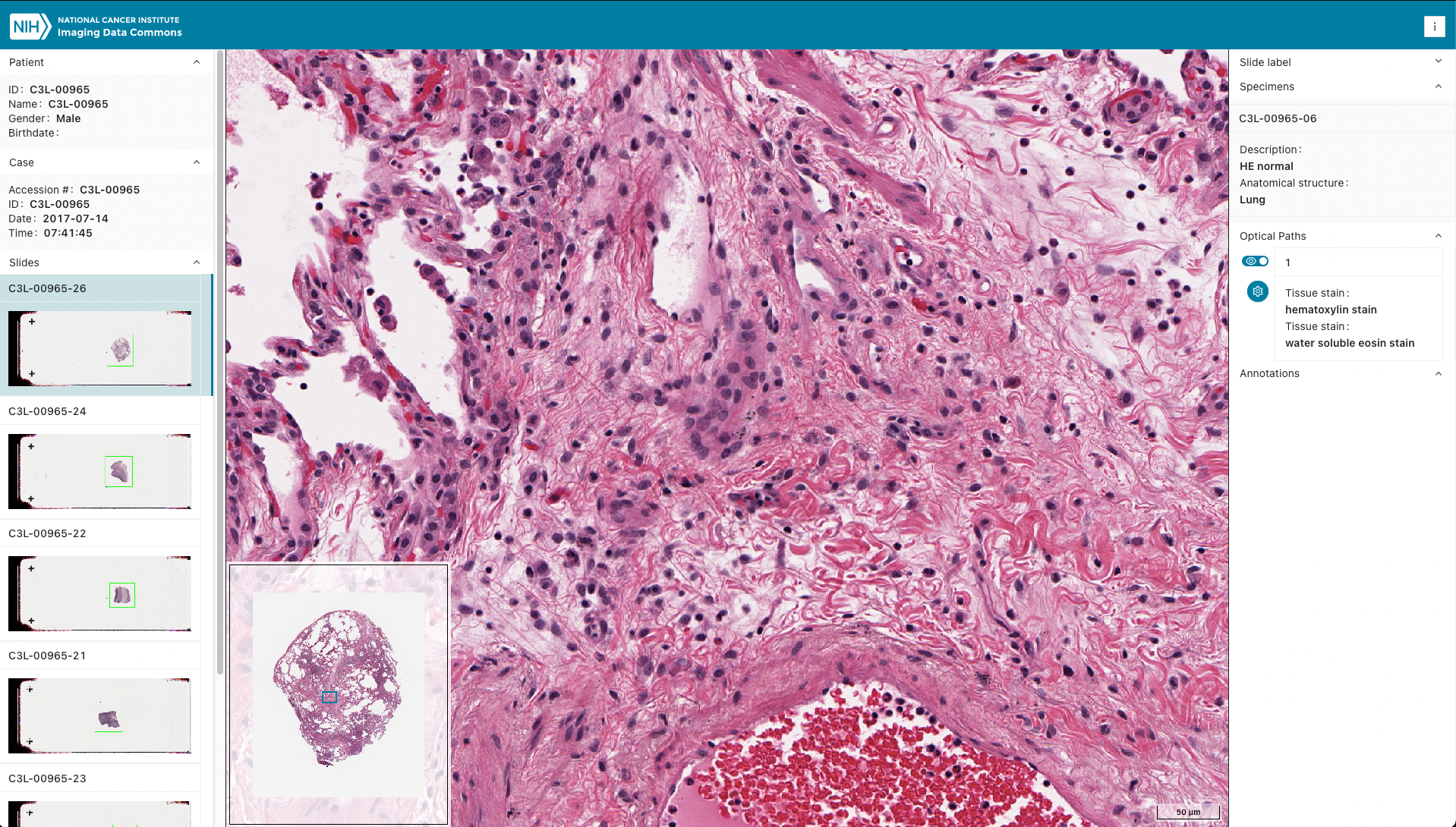Slim: Interoperable slide microscopy viewer and annotation tool for imaging data science and computational pathology
Slim is a single-page application for interactive visualization and annotation of digital whole slide microscopy images and derived image analysis results in standard DICOM format. The application is based on the dicom-microscopy-viewer JavaScript library and runs fully client side without any custom server components. It relies on DICOMweb RESTful services to search for, retrieve, and store imaging data and can thereby simply be placed in front of any DICOMweb-conformant Image Management System (IMS), Picture Archiving and Communication (PACS), or Vendor Neutral Archive (VNA).
Slim is used as the slide microscopy viewer by the National Cancer Institute's Imaging Data Commons (IDC).
Explore public IDC cancer imaging data collections by visiting the IDC web portal: portal.imaging.datacommons.cancer.gov.
The IDC viewer uses the Google Cloud Healthcare API as DICOMweb server.
Below you will find links to the representative DICOM SM images opened in Slim viewer:
- H&E: https://viewer.imaging.datacommons.cancer.gov/slim/studies/2.25.211094631316408413440371843585977094852/series/1.3.6.1.4.1.5962.99.1.208792987.352384958.1640886332827.2.0
- multichannel fluorescence: https://viewer.imaging.datacommons.cancer.gov/slim/studies/2.25.93749216439228361118017742627453453196/series/1.3.6.1.4.1.5962.99.1.2344794501.795090168.1655907236229.4.0?state=1.2.826.0.1.3680043.10.511.3.79630386778396943986328353882008803
Slim enables interactive visualization of DICOM VL Whole Slide Microscopy Image instances in a vendor-neutral and device-independent manner.
Interoperability with various image acquisition and management systems was successfully demonstrated at the DICOM WG-26 Connectathon at Path Visions 2020 and the DICOM WG-26 Hackathon at Path Visions 2021. Shown below are screenshots of examples images that are publicly available on the NEMA FTP server at medical.nema.org.
| Vendor | Illumination | Stain | |
|---|---|---|---|
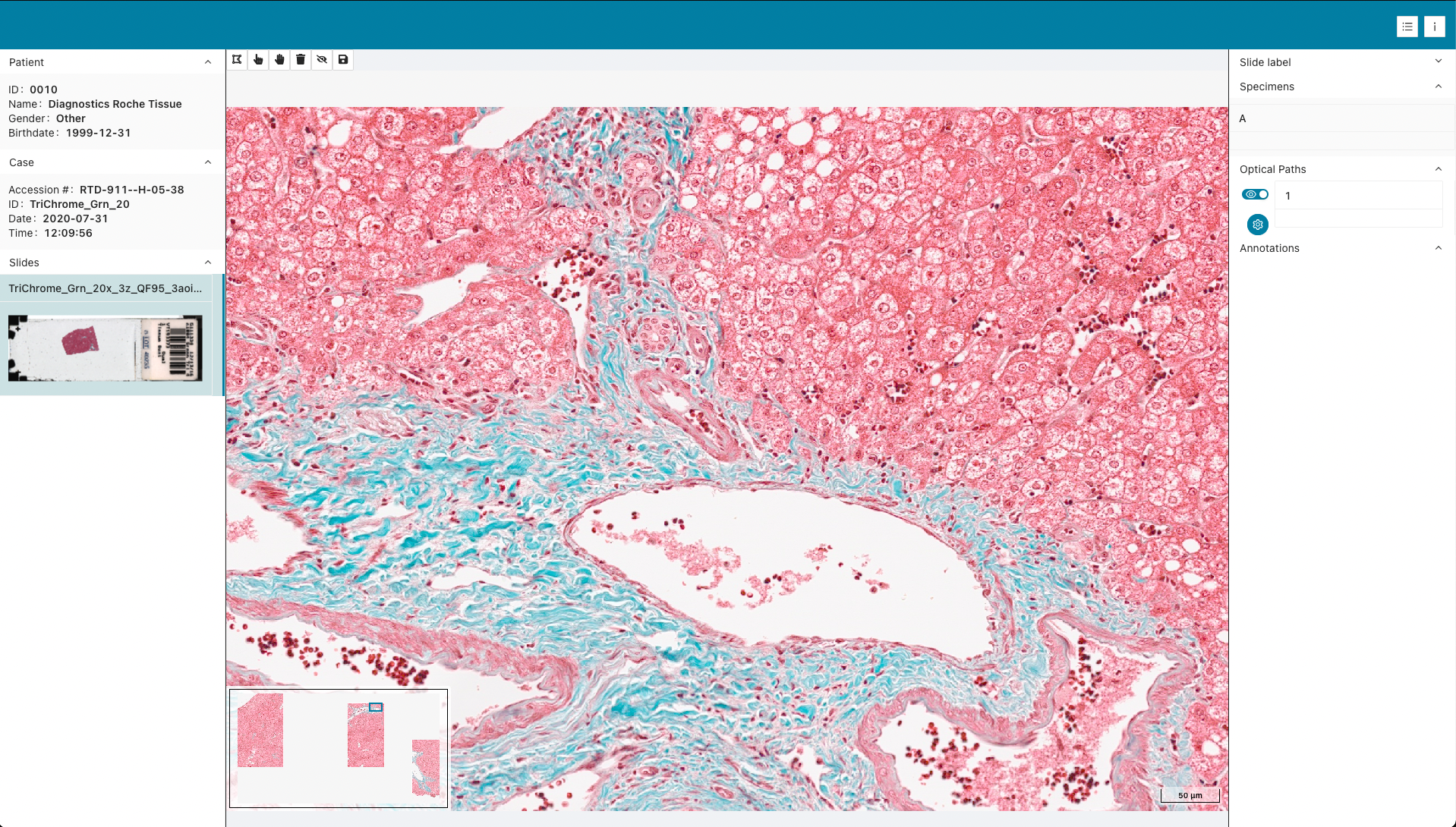 |
Roche Tissue Diagnostics | Brightfield | Trichrome |
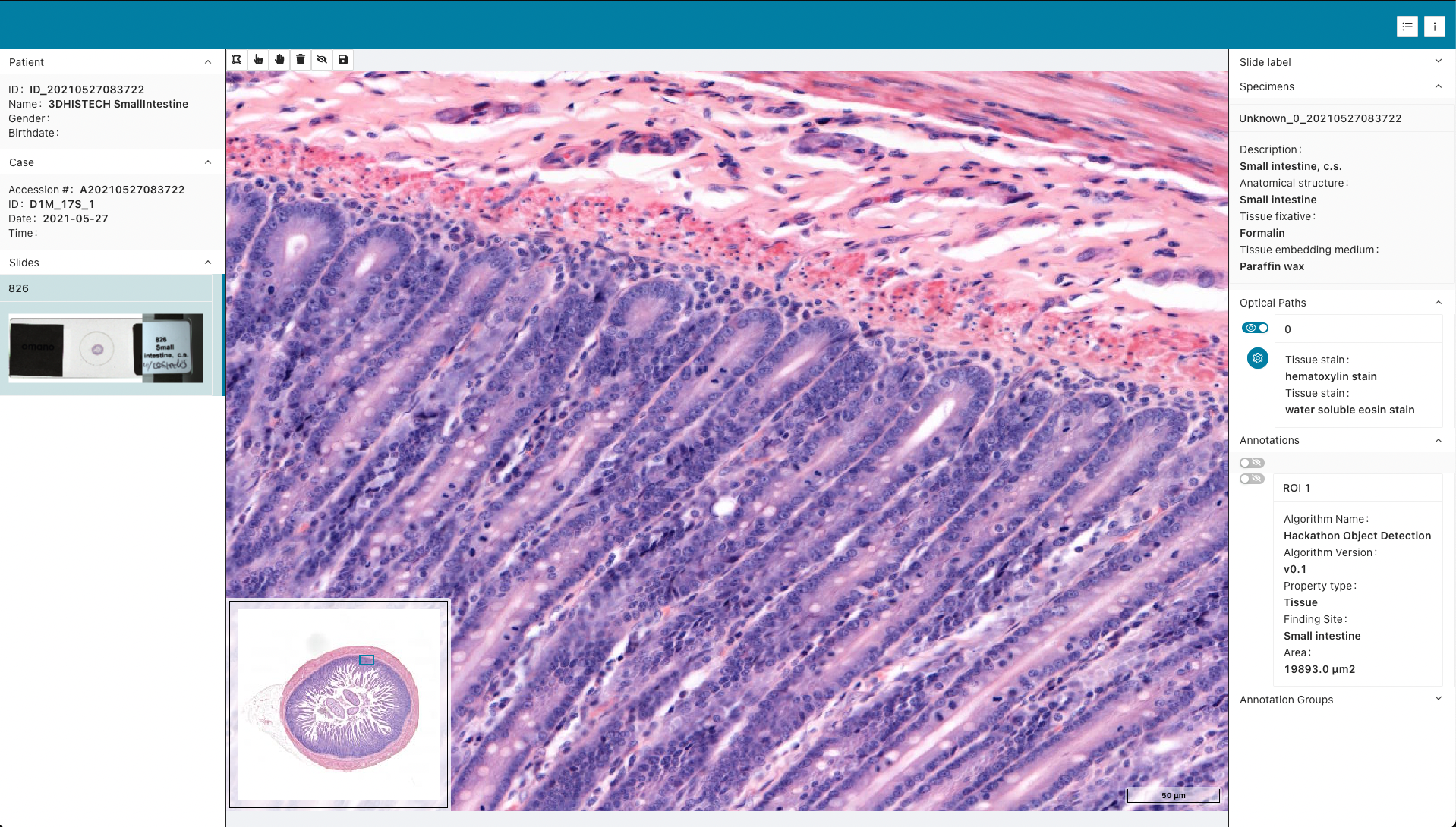 |
3DHISTECH | Brightfield | H&E |
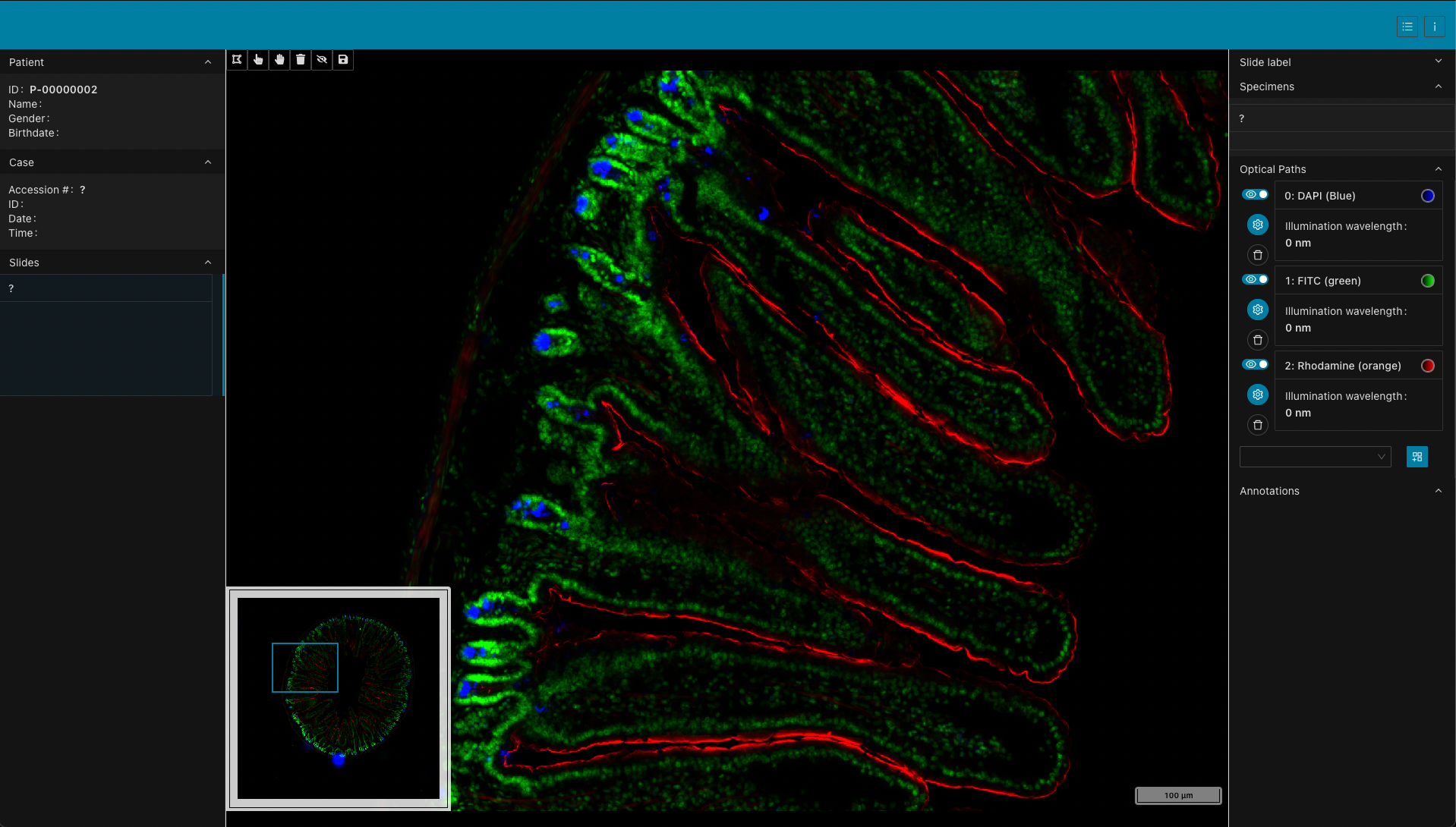 |
3DHISTECH | Fluorescence | DAPI, FITC, Rhodamine |
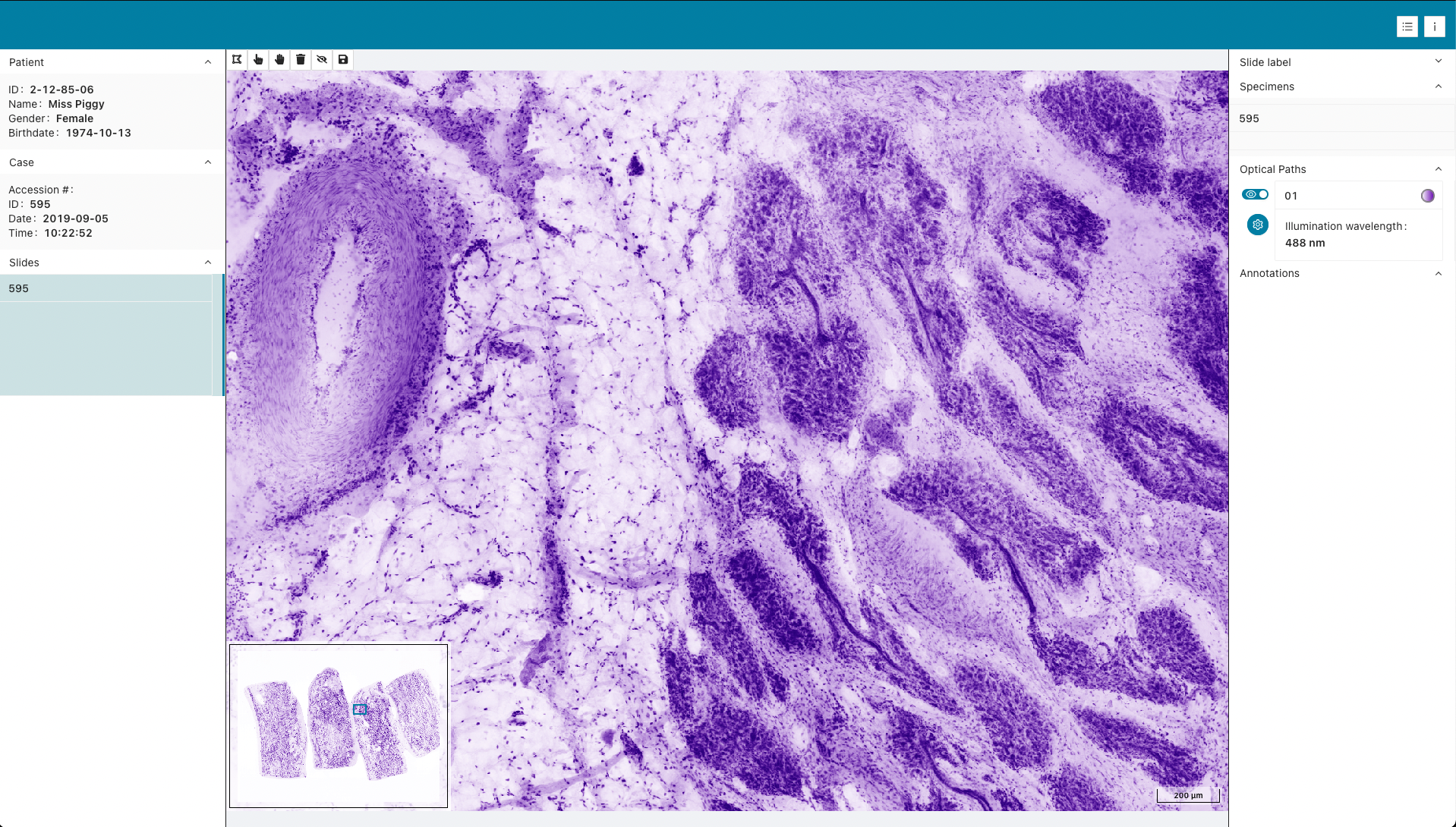 |
SamanTree Medical | Fluorescence | Histolog |
Slim further allows for interative visualization of image annotations and analysis results. The viewer currently supports the following types of DICOM instances:
Vector graphics:
- DICOM Comprehensive 3D SR instances that are structured according to template TID 1500 "Measurements Report" and contain planar image region of interest (ROI) annotations structured according to template TID 1410 "Planar ROI Measurements and Qualitative Evaluations"
- DICOM Microscopy Bulk Simple Annotations instances that contain groups of many ROI annotations (e.g., single cells)
Raster graphics:
- DICOM Segmentation instances that contain binary or fractional segmentation masks
- DICOM Parametric Map instances that contain saliency maps, attention maps, class activation maps, etc.
| DICOM IOD | |
|---|---|
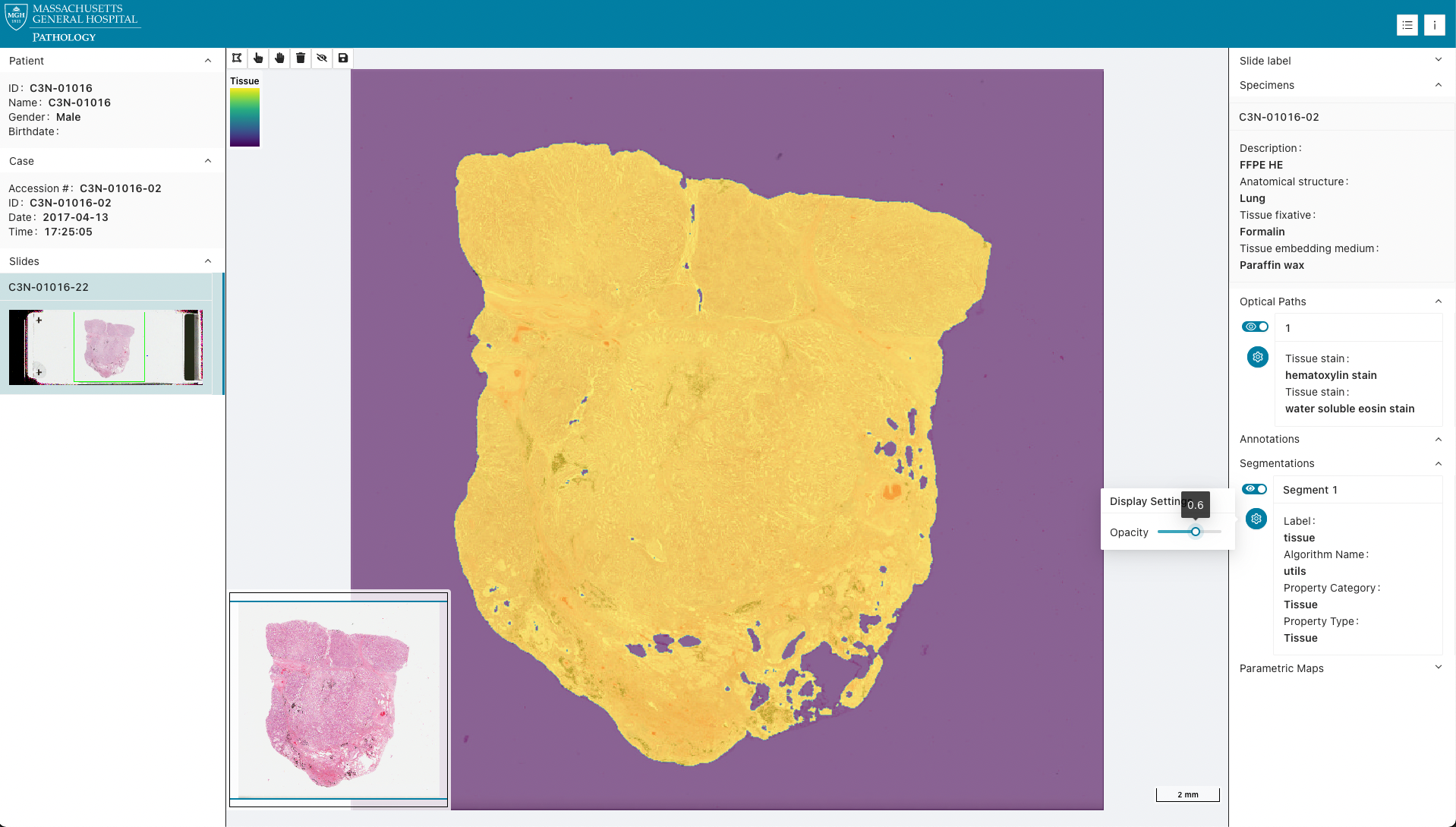 |
Segmentation |
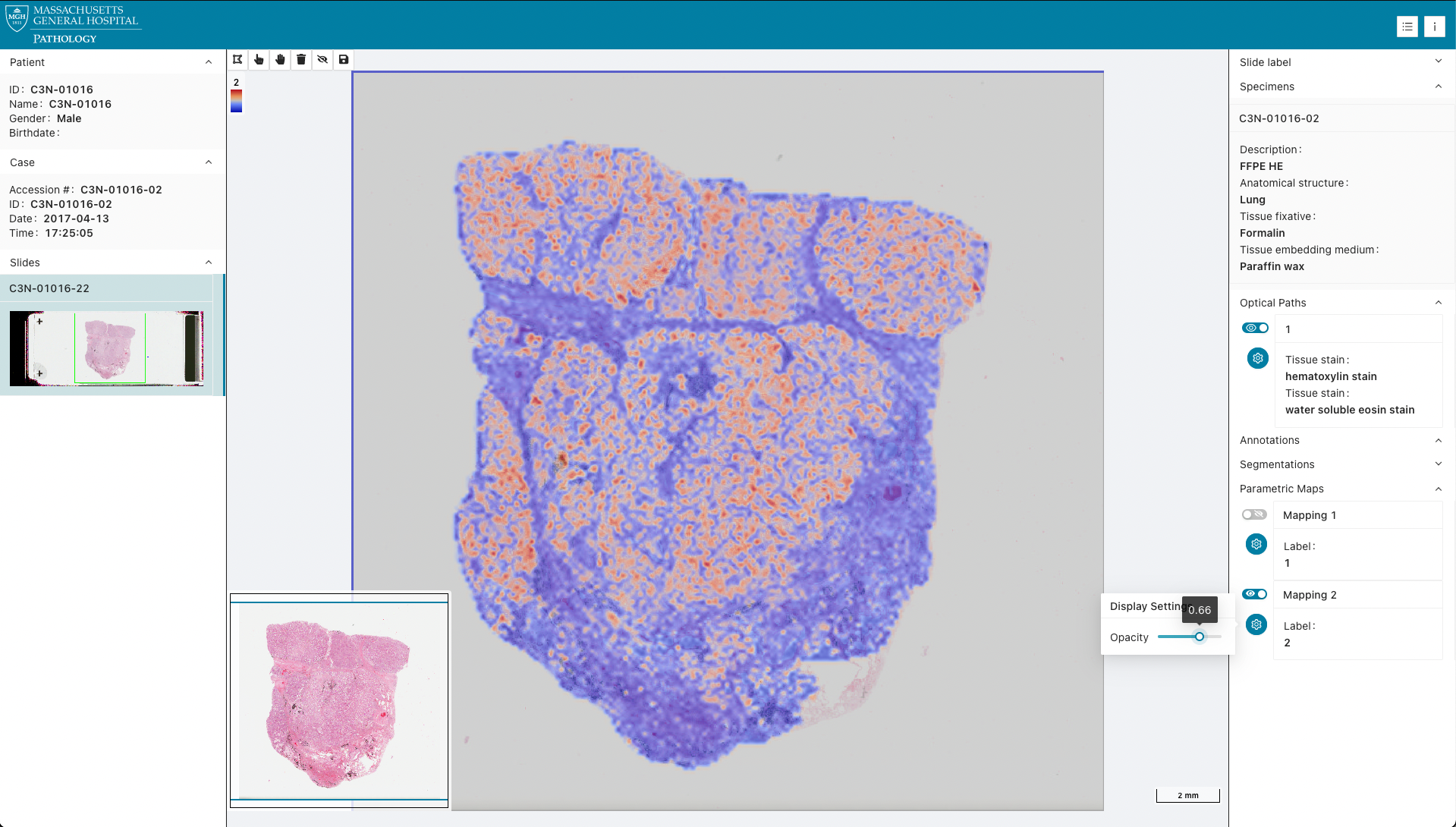 |
Parametric Map |
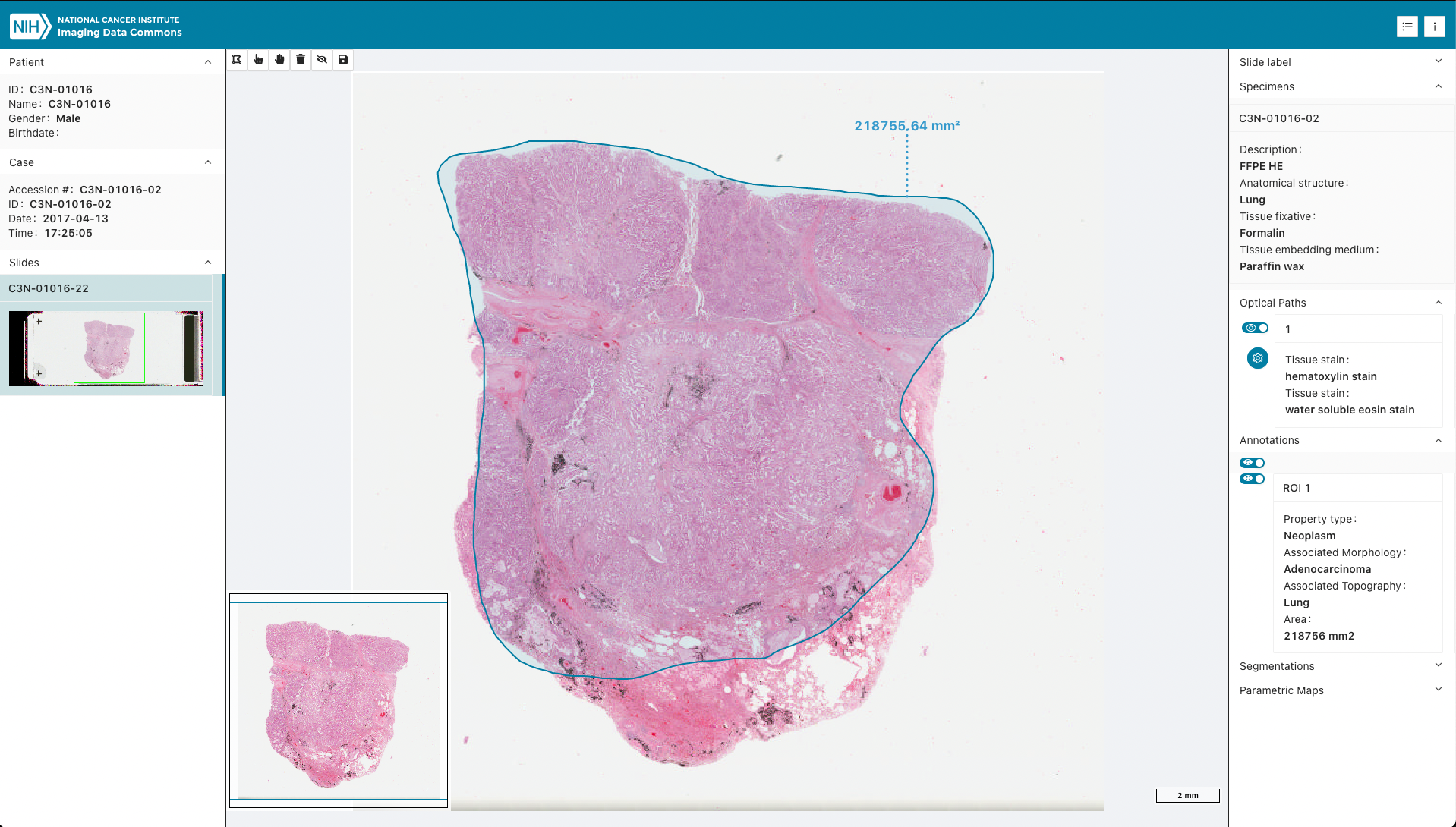 |
Comprehensive 3D SR |
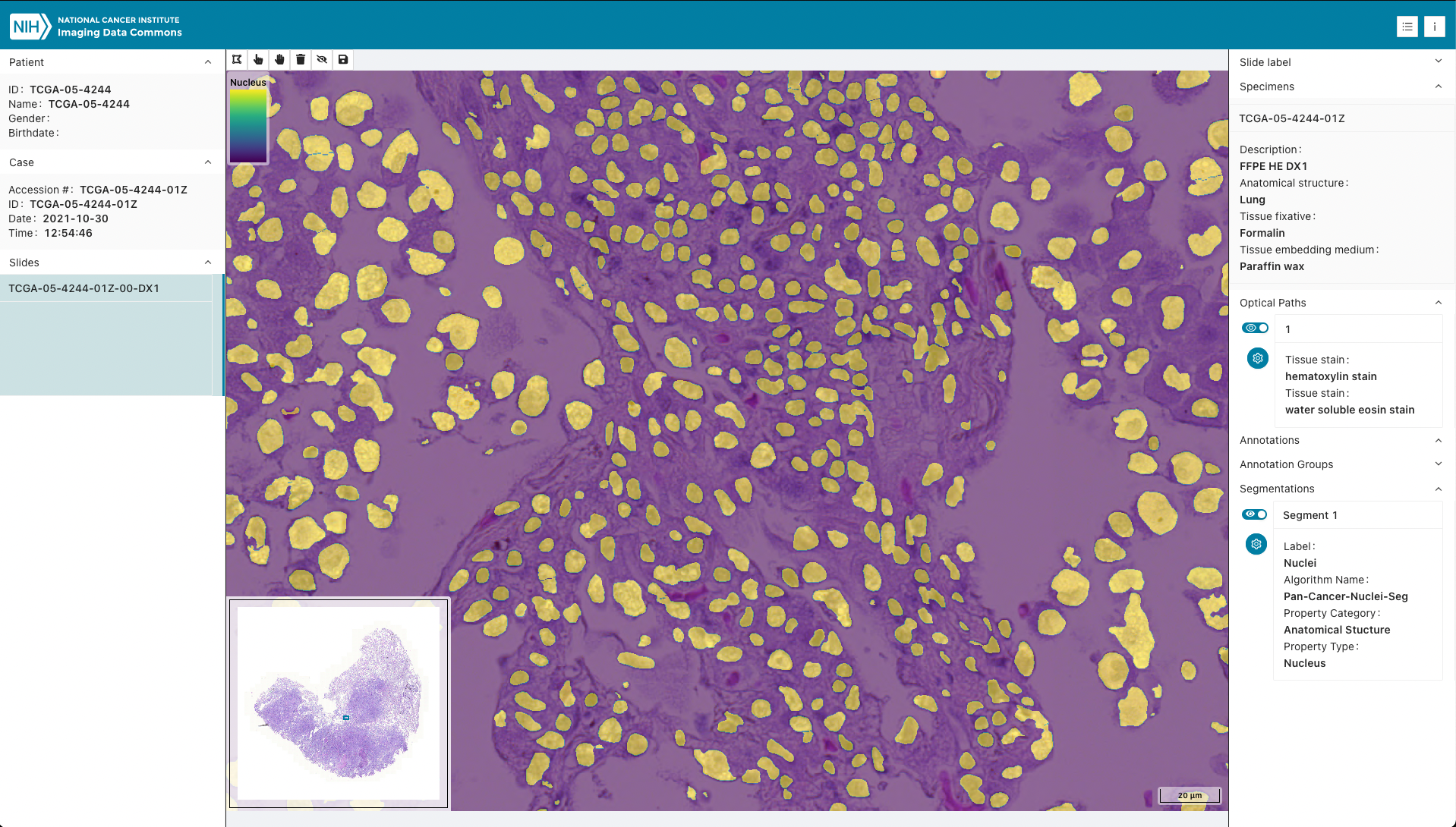 |
Segmentation |
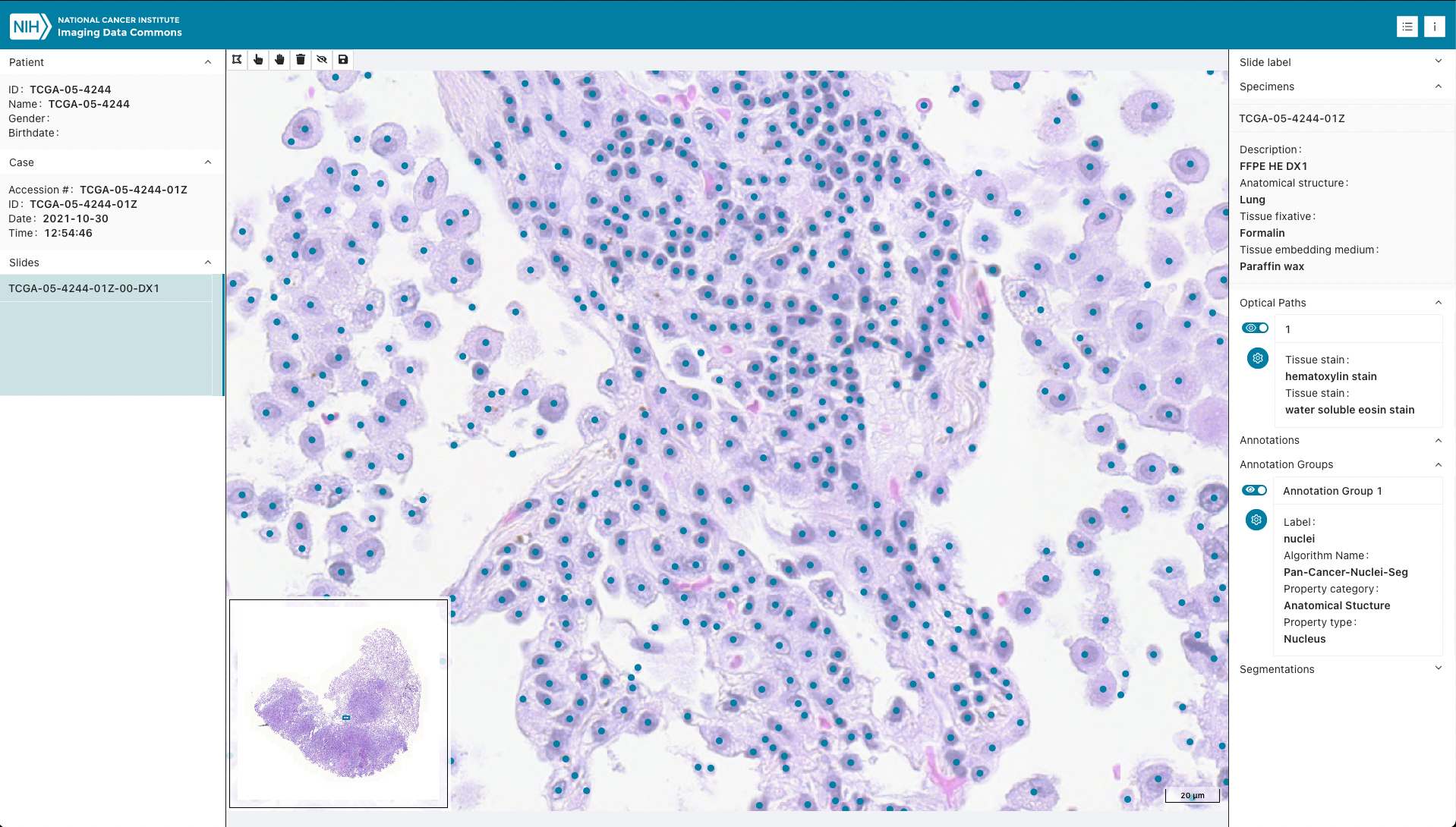 |
Microscopy Bulk Simple Annotations |
In addition to display, Slim provides annotation tools that allow users to create graphical image region of interest (ROI) annotations and store them as DICOM Comprehensive 3D SR instances using SR template TID 1500 "Measurement Report". ROIs are stored as 3D spatial coordinates (SCOORD3D) in millimeter unit according to SR template TID 1410 "Planar ROI Measurements and Qualitative Evaluations" together with measurements and qualitative evaluations (labels). Specifically, Image Region is used to store the vector graphic data and Finding is used to describe what has been annotated using a standard medical terminology such as SNOMED CT. The terms that can be chosen by a user can be configured (see AppConfig.d.ts).
Users can authenticate and authorize the application to access data via OpenID Connect (OIDC) based on the OAuth 2.0 protocol using either the authorization code grant type (with Proof Key for Code Exchange (PKCE) extension) or the legacy implicit grant type.
The app can be configured via a public/config/{name}.js JavaScript configuration file (see for example the default public/config/local.js).
Please refer to the AppConfig.d.ts file for configuration options.
The configuration can be changed at build-time using the REACT_APP_CONFIG environment variable.
When deploying SLIM with HTTPS, you may encounter mixed content scenarios where your PACS/VNA server returns HTTP URLs in its responses. This commonly occurs when:
- The PACS server populates bulkdataURI fields with internal HTTP URLs
- Your viewer is running on HTTPS but needs to communicate with services that respond with HTTP URLs
- You're using a reverse proxy that terminates SSL
To handle these scenarios, SLIM provides the upgradeInsecureRequests option in the server configuration:
window.config = {
servers: [{
id: "local",
url: "https://your-server.com/dcm4chee-arc/aets/MYAET/rs",
upgradeInsecureRequests: true // Enable automatic HTTP -> HTTPS upgrade
}]
}When upgradeInsecureRequests is set to true and at least one of your URLs (service URL, QIDO, WADO, or STOW prefixes) uses HTTPS, the viewer will automatically:
- Add the
Content-Security-Policy: upgrade-insecure-requestsheader to requests - Attempt to upgrade any HTTP responses to HTTPS
This feature was implemented in response to issue #159 where PACS servers would return HTTP bulkdata URIs even when accessed via HTTPS.
Configure message popup notifications that appear at the top of the screen. By default, all message popups are enabled.
window.config = {
// ... other config options ...
messages: {
disabled: ['warning', 'info'], // Disable specific message types
duration: 5, // Show messages for 5 seconds
top: 100 // Show 100px from top of screen
}
}Options:
disabled: Disable specific message types or all messagesduration: How long messages are shown (in seconds)top: Distance from top of screen (in pixels)
Available message types:
success- Green popupserror- Red popupswarning- Yellow popupsinfo- Blue popups
Examples:
// Disable specific types with custom duration and position
messages: {
disabled: ['warning', 'info'],
duration: 5, // Show for 5 seconds
top: 50 // Show 50px from top
}// Disable all popups
messages: {
disabled: true
}Default values if not specified:
duration: 5 secondstop: 100 pixels
Download the latest release from github.com/imagingdatacommons/slim/releases and then run the following commands to install build dependencies and build the app:
yarn install
PUBLIC_URL=/ yarn build
Once the app has been built, the content of the build folder can be directly served by a static web server at the location specified by PUBLIC_URL (in this case at /).
The PUBLIC_URL must be either a full URL or a relative path to the location at which the viewer application will get deployed (e.g., PUBLIC_URL=https://imagingdatacommons.github.io/slim or PUBLIC_URL='/slim').
To learn how to deploy Slim as a Google Firebase webapp, consider this tutorial.
The repository provides a Docker compose file to deploy a static web server and a dcm4chee-arc-light DICOMweb server on localhost for local app development and testing:
docker-compose up -d
The local deployment serves the app via an NGINX web server at http://localhost:8008 and exposes the DICOMweb services at http://localhost:8008/dcm4chee-arc/aets/DCM4CHEE/rs.
Once the serives are up, one can store DICOM objects in the archive using the Store transaction of the DICOMweb Studies Service.
The command line interface of the dicomweb-client Python package makes storing DICOM files in the archive straight forward:
dicomweb_client -vv --url http://localhost:8008/dcm4chee-arc/aets/DCM4CHEE/rs store instances -h
The local deployment uses the default configuration file public/config/local.js:
window.config = {
path: "/",
servers: [
{
id: "local",
url: "http://localhost:8008/dcm4chee-arc/aets/DCM4CHEE/rs",
write: true
}
],
annotations: [
{
finding: {
value: '85756007',
schemeDesignator: 'SCT',
meaning: 'Tissue'
},
style: {
stroke: {
color: [251, 134, 4, 1],
width: 2
},
fill: {
color: [255, 255, 255, 0.2]
}
}
}
]
};Customize the configuration according to your needs at either build-time or run-time.
Slim can be readily configured to connect to a secured DICOMweb endpoint of the Google Cloud Healthcare API with OIDC authentication:
const gcpProject = ""
const gcpLocation = ""
const gcpDataset = ""
const gcpStore = ""
const gcpClientID = ""
window.config = {
path: "/",
servers: [
{
id: "gcp",
url: `https://healthcare.googleapis.com/v1/projects/${gcpProject}/locations/${gcpLocation}/datasets/${gcpDataset}/dicomStores/${gcpStore}/dicomWeb`,
write: true
}
],
oidc: {
authority: "https://accounts.google.com",
clientId: gcpClientID,
scope: "email profile openid https://www.googleapis.com/auth/cloud-healthcare",
grantType: "implicit",
endSessionEndpoint: "https://www.google.com/accounts/Logout"
},
annotations: [
{
finding: {
value: '108369006',
schemeDesignator: 'SCT',
meaning: 'Neoplasm'
},
style: {
stroke: {
color: [251, 134, 4, 1],
width: 2
},
fill: {
color: [255, 255, 255, 0.2]
}
}
},
{
finding: {
value: '85756007',
schemeDesignator: 'SCT',
meaning: 'Tissue'
},
style: {
stroke: {
color: [255, 255, 0, 1],
width: 2
},
fill: {
color: [255, 255, 255, 0.2]
}
}
}
]
};Create an OIDC client ID for web application.
Note that Google's OIDC implementation does currently not yet support the authorization code grant type with PKCE challenge for private clients. For the time being, the legacy implicit grand type has to be used.
To install requirements and run the app for local development, run the following commands:
yarn install
yarn start
This will serve the app via a development server at http://localhost:3000 using the default local configuration.
The configuration can be specified using the REACT_APP_CONFIG environment variable, which can be set either in the .env file or directly in the command line:
REACT_APP_CONFIG=local yarn start
For more information about the motivation, design, and capabilities of Slim, please see the following article:
Interoperable slide microscopy viewer and annotation tool for imaging data science and computational pathology C. Gorman, D. Punzo, I. Octaviano, S. Pieper, W.J.R. Longabaugh, D.A. Clunie, R. Kikinis, A.Y. Fedorov, M.D. Herrmann Nature Communications 4:1572 (2023)
If you use Slim in your research, please cite the above article.
The DICOM conformance statement for Slim is available in this repository here
